
In December, 2015 the Los Angeles County Sheriff’s Department released a LA County Inspector General report on the department’s new Smith & Wesson M&P pistols. The report indicated that the new 9mm pistols were prone to accidental (negligent) discharges that endangered the Deputies and the community alike. In addition, the report identified a breakdown in the selection process, inadequate training during transition, and improper training on new pistol mounted lights. In essence, the M&P pistols are unsafe!
Smith & Wesson M&P pistols have been making very respectable gains against the large majority claim that Glock has held on American law enforcement handguns, this news is more than a little troubling. My experiences with M&P pistols have found them to be very reliable, and accurate pistols, and the grip design is one of the most ergonomically sound and comfortable grips on the market, in my opinion.
A Troubling Rise in Negligent Discharges
A very short time after the Los Angeles County Sheriff’s Department (LASD) transitioned to the Smith & Wesson M&P 9mm pistols, the department began documenting a very troubling rise in negligent discharges (ND) by deputies. These ND incidents were occurring both on and off-duty, and were disproportionately higher with the M&P pistols over the Beretta’s. As a result, the Sheriff reported the problem to the County’s Office of Inspector General for an in-depth investigation to determine the cause.
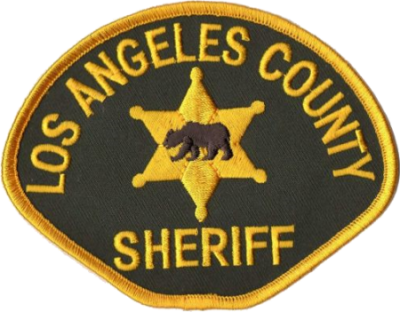
A negligent discharge is a serious concern for any department, as BlueSheepDog has posted before. In a very densely populated and urban county like Los Angeles, an ND can be even more dangerous. The chances of an errant bullet striking a person is much higher, and the wealth of attorneys makes million dollar judgments or settlements likely.
I will provide some background on the LASD’s use of the Beretta 92, the selection of the Smith & Wesson M&P, and the problems in transition training to the M&P documented problems located by the OIG.
Smith & Wesson M&P 9mm
The Smith & Wesson M&P series has become one of the legendary company’s most popular lines, and the 9mm version has risen with the resurgence of advanced 9mm cartridges. When the modern M&P line was first introduced in 2005 it was a tremendous improvement to the company’s disappointing release of the polymer-framed Sigma series of the 1990’s.
The M&P line of polymer-framed, striker-fired pistols have been noted for their much improved design, presented in a new but still classic pistol profile. Made with a Zytel polymer frame, and a Melonite coated steel slide, the M&P was what everyone expected of Smith & Wesson’s polymer-framed pistol competition.
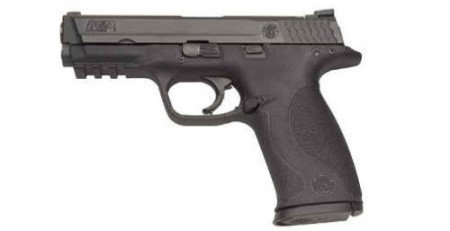
The original M&P hinged trigger had some issues that some shooters attributed to poor trigger pull, trigger reset, and increased misfeeds. However, Smith & Wesson was quick to respond to the complaints and an enhanced hinged trigger, with stronger springs, was released that has mostly eliminated the complaints associated with the trigger.
Los Angeles County Sheriff’s Department M&P Selection
The Los County Angeles County Sheriff’s Department had issued the all-steel Beretta 92F 9mm pistol since 1992. The Beretta uses an external safety lever, with an ominous 11.5 pound double-action trigger pull. The Beretta’s DA/SA action, with a long, heavy double-action first trigger pull, followed by a much lighter single-action trigger pull, was very popular at the time. Despite the problems reported on military M9 Berettas (many of which are very old now), the Beretta 92 design is actually a very good one. The pistols are easy to operate, with a smooth recoil, and are easy to field strip and maintain.
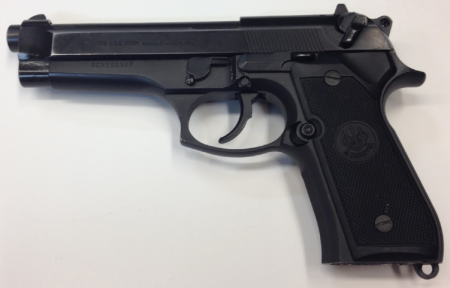
However, the market literally exploded with new technology in the last decade, and the largest Sheriff’s Department in America realized it was time to re-evaluate their duty sidearm selection. The polymer-framed, striker-fired action of the M&P pistols provided a lighter package with a respectable 6.5 pound trigger pull. They also offered an integrated Picatinny rail for easy addition of a pistol-mounted light.

The official selection process began in 2007, when the Weapons Training Unit (WTU) started evaluating the Smith & Wesson M&P pistols as a duty pistol option. NOTE: Early models of the M&P pistols had an undisclosed problem and were sent back to Smith & Wesson. According to the OIG report S&W fixed the issue and training and issuance continued.
- 2007 – WTU starts evaluation of Smith & Wesson M&P pistols
- 2008 – Uniform & Safety Committee approves M&P as optional duty handgun
- 2009 – Consultant group reports Beretta disproportionately eliminates females
- 2011 – Chief of Training: end Beretta purchases, contract with Smith & Wesson
- 2011 – Chief of Training: contract with Surefire for pistol-mounted lights
- 2011 – New Academy training classes begin solely training with M&P pistols
- 2013 – LASD enters contract with S&W for up to 20,000 M&P 9mm pistols
- 2013 – LASD enters sole-source contract with Surefire for 20,000 X300 lights
- 2013 – LASD offers veteran deputies option to transition to M&P (8-hour course).
LASD identified the following features of the Smith & Wesson M&P pistols as being advantageous over their previously standard issued Beretta 92:
- Adjustable grip sizes – S, M, L
- Consistent trigger pull (6.5 lbs. versus 11.5 lbs.)
- Lighter overall weight
- Remedial Academy pistol training drops from 61.3% (Beretta) to high of 16.8% (M&P).
BlueSheepdog has advocated for pistol-mounted lights for some time, as long as officers are properly trained and understand not to use the lights as regular flashlights. We recognize the incredible advantage during low light conditions over traditional hand-held lights with a one-handed pistol grip. However, use of a pistol-mounted light is not a simple skill to learn, and any department or individual officer must dedicate significant time training to master the skill.
LA Sheriff Transitions to M&P Pistols
By the end of 2014, transition training to the new M&P had progressed rapidly with 3,061 of 9,455 armed deputies having been trained and transitioned into the Smith & Wesson M&P pistol. Training has continued through 2015, despite the ongoing investigation by the County OIG, with over 6,000 M&P pistols in service now.
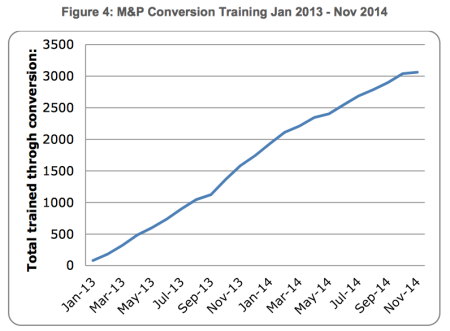
The LASD provided the Surefire X300 pistol-mounted light, but did not provide the DG pressure grip activation. However, LASD training staff recommended that deputies purchase this addition on their own, and it was apparently approved by the department to be added to duty firearms.
Negligent Discharge Investigations
Whenever a LASD deputy unintentionally discharges their firearm, they must immediately report it to their Sergeant. The Sergeant must investigate and then report the incident to the Watch Commander, typically a Lieutenant. After the Watch Commander evaluates the circumstances, they are required to notify the on-call Lieutenant of the Internal Affairs Division to determine if further investigation was warranted. The only required investigation by IAD was if the unintentional discharge struck a person, otherwise the Watch Commander would complete the investigation.
LA County OIG Report
Based upon the alarming increase in ND’s, LA County Sheriff Jim McDonnell notified the County Office of Inspector General (OIG) and requested an investigation. The OIG published a report on their findings just a few days ago, and the implications are significantly noteworthy.
The Los Angeles County OIG investigated several components of the Smith & Wesson M&P, and have published their report just a few days ago:
- Selection and purchase of M&P pistols
- Selection and purchase of Surefire pistol-mounted lights
- Training and transition courses
- Unintended discharge accountability and investigation
- Participation in a transition training course
- Review of appropriate Manuals and documentation
- Review of other agencies experiences with Smith & Wesson M&P pistols.
The internal audit and investigation revealed a significant increase in unintended discharges when deputies were handling their Smith & Wesson M&P pistols. In the two years since the M&P pistols were officially made the LASD approved handgun the number of ND’s increased over 100% from years where the Beretta 92 was still the department’s official handgun.
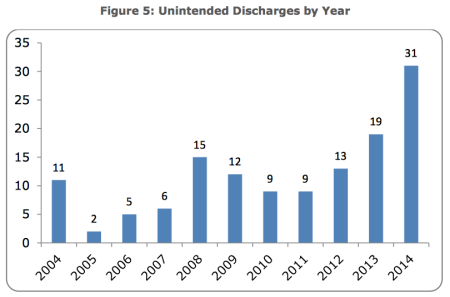
2012 Negligent Discharges
In 2012, prior to the official change to M&P pistols, there were (13) unintended discharges, of all manner of firearms. The Beretta accounted for (3) discharges, and an approved alternative Sig Sauer accounted for (3) discharges. Interestingly, the M&P pistols did not account for any discharges. Four discharges occurred off-duty, with the rest being on-duty.
2013 Negligent Discharges
However, in 2013 the number of unintended discharges rose to (19), with the Smith & Wesson M&P pistols accounting for nearly half of those discharges.
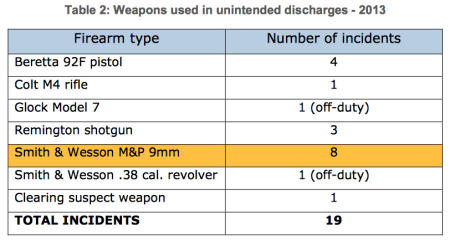
The (8) M&P discharges were committed by (3) Academy trained deputies and (5) veteran transition-trained deputies. The disparity of Academy trained deputies and veteran transition-trained deputies may be showing some light into the problem.
2014 Negligent Discharges
By 2014 the M&P pistols were the clearly dominant firearm causing ND’s with LASD deputies. Very interestingly, the majority of the deputies involved were assigned to the Custody Division (jail and transport), where the deputies spend a significant amount of on-duty time unarmed – with their pistols locked in lockers.
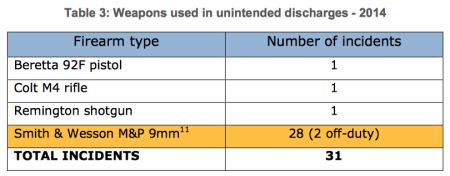
The 2o14 unintended discharges (ND’s) were committed by (1) Academy trained deputy, and (22) veteran transition-trained deputies. Of particular note is (4) deputies had no documented training on the M&P at all. Whether they had the ND’s with their own department-issued M&P pistols or another deputy’s pistol is not identified.
Thankfully, despite the serious increase in ND’s, the number of injuries did not rise. No civilians were harmed (thank God!), and only (6) deputies were injured; (3) on-duty, and (3) off-duty. Of those involved (5) were deputies, and (1) was a Sergeant. In addition, two of the on-duty incidents involved a S&W Shield and a M&P Compact pistol. One of the off-duty incidents involved a M&P Compact.
2015 Negligent Discharges
In 2015, there were (21) ND’s involving the M&P pistols up to the point the OIG investigation was concluded for its report (an unknown date). Particularly alarming is the fact (18) of the ND’s were on-duty! Of all the ND’s (14) involved the M&P pistols, while only (1) involved the Beretta. In 2015, four deputies had been injured by ND’s – (3) self-inflicted and (1) from a ricochet.
“The Department attributes this reduction from peak levels in 2014 to its mitigation program. However it may also be attributable to the passage of time, allowing many deputies to become more familiar with their weapon outside of training provided by the Department. If the Department is correct, then additional training may be able to make the chosen platform safe.”
The OIG report separated all of the NG incidents into (2) categories: tactical or non-tactical.
- Tactical – on-duty ND during duty-related actions
- Non-Tactical – cleaning, clearing, holstering.
Tactical vs. Non-Tactical ND’s
Obviously Tactical ND’s are a much greater concern to the LASD and to the community, as they present a far greater risk of unintentional injury. In 2012, most of the ND’s were Non-Tactical and few involved pistols. There was a wide variety of firearms involved, including Remington 870 shotguns and a Colt M4 rifle (yikes).

By 2013, however, Non-Tactical ND’s only accounted for 53% (10) of the overall discharges. Of these, (2) were with the Beretta 92 and (5) were with the Smith & Wesson M&P. The (9) Tactical ND’s involved (2) Beretta 92 and (3) Smith & Wesson M&P pistols. The remainder were attributed to other firearms.
In 2014 the Non-Tactical ND’s had dropped to 39% (12) while over 60% (19) were on-duty Tactical ND’s. The disparity of the Smith & Wesson M&P’s involvement in ND’s becomes much more clear in 2014. All (12) Non-Tactical ND’s were with the M&P and an incredible 84%, (16) of the (19), Tactical ND’s were with the M&P pistols.
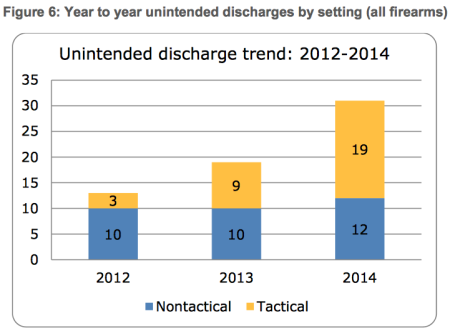
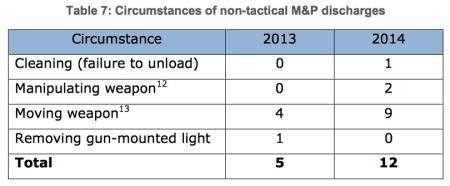
LA County OIG Determinations of ND Causes
The OIG report identified several causes or contributors to the rise in ND’s after the transition to the M&P pistols. Some of these causes involved the selection process, some involved the change in safeties, and others involved deputies violating the Cardinal Rules of Firearm Safety.
- Smith & Wesson not having an external safety
- Beretta having a nearly 5.0 pound heavier trigger
- Deputy over-confidence in Beretta not having ND (external safety, heavier trigger)
- Deputies placing finger on trigger – violating safety rules.
In fact, the LASD Weapons Training Unit identified the following in their own investigation:
“Of note, the analysis revealed two primary causal factors which may explain the increase in unintentional discharges:
- Poor trigger discipline and
- Failure to adhere to the Four Basic Firearms Safety Rules.”
Those identified problems cannot be understated! Neither involves the firearm. Instead both involve the deputies errors, and could highlight an even greater problem in training.
Faulty Firearms Training
Interestingly, until 2002 LASD deputies were trained by their department “on target, on trigger”. In other words, if the deputy pointed their firearm at a subject, their finger was already on the trigger. That may have been viewed as acceptable with the Beretta 92, if further instruction required the manual safety to be left on until a determination to fire had been made. Still, this revelation is astoundingly alarming to me, especially from the nation’s largest Sheriff’s Department and one that many would look up to as being on the front line of modern American law enforcement. The rules of safe firearm handling have always included staying off the trigger until ready to fire.
This training, even though halted over a decade before these events, must have had a lingering effect. Of the (31) ND’s during 2013-2014, all but (2) involved the deputy having their finger on the trigger! The OIG report indicated that this practice of “riding the trigger” played a significant role in ND’s during Tactical situations. In another distressing revelation, it was found the deputies had their ND when they were not even on target:
“Our review found no instances where the deputy actually had his M&P “on target” when a reported unintended discharge occurred. In fact, during interviews, some LASD staff expressed the opinion that many deputies habitually placed their fingers on the trigger in a potentially adversarial setting even when not pointing their gun at a suspect. The presence or absence of an external safety lever is not as relevant in tactical circumstances, as once a deputy draws a pistol in a potentially adversarial setting, he or she would generally flip the safety to the “off” position when using the Beretta 92F.”
External Safety a Non-Issue
It’s interesting to note the OIG’s conclusion that the Beretta 92’s external safety likely would not play a significant role in the increase, as it would be likely that deputies would disengage the safety immediately upon drawing the pistol. This makes perfect sense to me. When I started in law enforcement we were issued .45 caliber Smith & Wesson 4566‘s, with an external safety/hammer drop lever. We were instructed to disengage the safety immediately upon drawing the weapon. However, we were also instructed on the Safety Rules, and were not to engage the trigger until ready to fire.
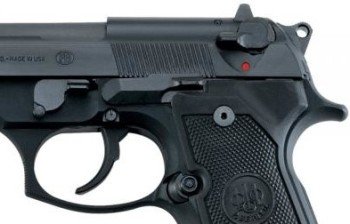
The OIG report did acknowledge that a deputy would be much less likely to have an ND with the Beretta 92 even with “riding the trigger” because of the 11.5 pound trigger pull, as opposed to the M&P’s 6.5 pound trigger pull. This makes sense, but highlights the devastatingly bad decision to train deputies to “ride the trigger” on any firearm.
LA County deputies now have a “splash page” appear anytime they log into a department computer reminding them of the (4) Cardinal Rules of Firearm Safety.
Weapon Light Manipulation ND’s
Although the decision to include Surefire X300 weapon lights on the new M&P pistols was made, weapon light manipulation was only responsible for 32% of ND’s overall. Though still a significant number, it cannot be understated that the inappropriate training on firearms safety and trigger manipulation is much more responsible for the ND crisis at LASD.
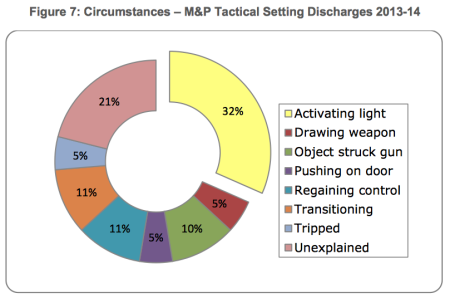
Of particular note is the fact that (5) of the (6) ND’s involving the manipulation of the pistol light, occurred not by the manual manipulation of the on/off switch in front of the trigger guard (as most would expect), but by the depression of the grip activation switch. This is just another indictment on a flawed training concept of having the trigger finger on the trigger. The sympathetic reflex effect of squeezing the grip activation, and the trigger finger squeezing (sympathetically) are likely the causes of this ND’s.
The pistol light ND not involving the grip activation involved a deputy directing traffic with his pistol light instead of his flashlight. You can’t make these things up, there really are buffoons wearing badges who do these things!
OIG Summary of ND’s 2012-2014
- From 2012 to 2014, unintended discharges rose by 138%
- From 2012 to 2014, tactical unintended discharges rose by more than 500%
- Prior to 2014, unintended discharges were largely confined to non-tactical settings
- By 2014, nineteen of the thirty-one incidents, or 61%, took place in tactical settings
- Prior to the field deployment of the Smith & Wesson M&P pistol in 2013, a broad mix of weapons were involved in unintended discharge events
- In 2014, one weapon, the M&P accounted for 90% of all such incidents even though only about 32% of armed employees had converted to the M&P by the end of 2014
- (2015 – Fourteen of eighteen on-duty, and 15 of 20 overall ND’s involved M&P).
LASD Firearms Training
The transition training consisted of only an 8-hour course, of which, 4 hours were classroom instruction on the M&P, field stripping, cleaning & maintenance, and features. Deputies were instructed about the absence of an external safety, and to not use the pistol mounted light unless they were in a deadly force situation.
When activating the Surefire pistol light deputies were instructed to use their off-hand to manipulate the on/off lever, or to use the DG grip activation switch if they had purchased that option. However, instructors also instructed to activate the DG switch immediately upon drawing the firearm and to make this action “an automatic part” of the drawing process. They reasoned it would eliminate a decision-making process (to activate the light) at a later point in the event.
In my opinion, this instruction is extremely flawed! First, drawing a weapon may be in a circumstance where stealth is an important factor – where activating a light would be self-defeating. In addition, weapon lights are best used intermittently until a definite threat is identified. At that point full lights-on the suspect is most appropriate. Teaching a full lights-on method is just asking deputies to abuse the pistol light for a flashlight.
The OIG report found that the 8-hour training course was well put together and comprehensive in approach, but it lacked the time to defeat “old muscle memory” and to properly teach new methods on a new firearm.
Selection of the M&P & Surefire X300
The selection of the M&P as the replacement for the Beretta 92 involved the recommendations of the outside consultant group. The previously mentioned benefits of the M&P played a significant role in the decision-making. Consistent trigger pull, interchangeable grip sizes, and weapon mounted light options were all significant improvements.
In addition, the LASD claimed the Surefire X300 was the only light that could be used on other department approved pistols. It also had the other features desired by the department:
- Light Output – 500 lumens
- Ambidextrous controls
- Size – able to fit in holsters
- DG grip – only version capable of use with all LASD pistols
- Cost – Surefire offered the lights for under half of MSRP.
However, other options were available, and in some cases provided better operational aspects than the X300 light. For instance, the 500 lumens is an awesome amount of light in certain circumstances, but can be a significant detriment in others. When that much light hits a reflective surface like glass, mirrors, water or similar areas, the reflection can actually blind the officer temporarily. That produces a significant danger to officers.
LASD did not have a comprehensive selection process in place when deciding on the Surefire X300 light. In addition, despite the department’s claim that the X300 was suitable to the other approved pistols, the light has not been distributed to deputies with the other options. Only deputies issued the M&P have received X300 lights.
The costs of transition training, and in particular the addition of the X300 light in training, were not accurately vetted by LASD prior to purchase. This statement from the department is telling:
“No training costs are required as the current handgun mounted light training certification only requires watching a thirty minute department video via the internet. This training video can be watched during the course of a normal shift.”
How such a large and progressive department could believe that a video would be sufficient in training on weapon lights, a difficult technical skill, is beyond reason. However, the decision to acquire and use pistol-mounted lights was determined to be a sound decision (we agree).
The memo from the Chief of Training to acquire pistol lights did not mention a specific manufacturer. LASD claimed there was an extensive testing and evaluation process to determine the X300 was the best choice, but to date the OIG has received no documentation of this process. It sounds like the training unit did a rudimentary examination of the options and made a quick decision on the X300. Every cop should know, “if it’s not on paper, it didn’t happen”.
The OIG report noted several independent sources that cautioned about the use of the DG grip activation of pistol-mounted lights, including the Force Science Institute (FSI). The FSI has an impeccable reputation for studying and defending officers’ use of force based upon human perception and reaction realities. The LASD Special Enforcement Bureau uses the DG grip activation for their X300 lights, but they also train extensively on the system. This training is not afforded to patrol or detention deputies.
BlueSheepDog Final Thoughts
The Los Angeles County Sheriff’s Department problem with the Smith & Wesson M&P appears to be a training problem and not an actual problem with the pistol itself. Smith & Wesson M&P pistols are in the hands of thousands of officers and tens of thousands of civilians and have been vetted for proficiency and reliability. The M&P pistols are good pistols – period.
What has become strikingly obvious from the LASD experience, and noted in the OIG report is the absolute need for a proper training component. Typically a transition to a new sidearm would require a minimum of 8-hours of training. Flashlight training, particularly on a weapon-mounted version, should take at least 4-hours and likely another 8-hours of live-fire training. The LASD experiment pushed the transition training and weapon-mounted light training into one component. Considering the necessary classroom portion of the transition training (4 hours), that left a paltry 4-hours for live fire training and weapon-mounted light training.
There is serious consideration about how and why LASD chose to go to Smith & Wesson M&P pistols and the Surefire X300 pistol mounted lights as well, but the most serious consideration must be on the training of the deputies. Both the Smith & Wesson M&P pistols and the Surefire X300 lights are excellent products. As any government agency must do, a more comprehensive and detailed explanation must be provided for such large purchases.
The biggest concern involves the quick push to place X300 mounted M&P pistols into the hands of deputies. I do not doubt that the training division did its best to provide the transition training, but somewhere in the chain of command the ball was dropped in recognizing just how much training would be required. Changing pistols is daunting enough, but changing pistols and adding pistol-mounted lights at the same time is a recipe for disaster unless a robust training regiment is observed.
The BlueSheepDog staff do not feel the Smith & Wesson M&P pistols are unsafe, nor do we feel the X300 lights are dangerous. Like any firearm or accessory, proper training is key to success, even with the DG activation switch. In this case a large bureaucracy made decision to change (and most of those decisions were sound), but failed to recognize the importance of extra training to properly ensure the changes went through seamlessly. We have no doubt that corrected training procedures and times will dramatically alter the ND effects that LASD is suffering from.
A list of recommendations from the OIG report:
LA County OIG Recommendations
Recommendation 1 – Training
- 1.1 The LASD should evaluate the adequacy of its initial conversion training curriculum and also determine whether an eight-hour course is sufficient to overcome any ingrained habits. Given the result of the current training approach, a course of sixteen hours or more should be strongly considered.
- 1.2 The LASD should consider follow-up training and evaluation sessions for all conversion course graduates to monitor adherence to initial training of safety aspects and assign further training where needed.
- 1.3 The LASD should review low light training curricula for other departments and private vendors and evaluate whether its current curriculum reflects best training practices and is of sufficient duration to adequately train personnel.
- 1.4 The LASD should incorporate the use of both handheld lights and weapon-mounted lights into Continuous Professional Training. LASD should develop training standards for activation of the light that focuses on that equipment which is provided or required for trainees.
Recommendation 2
The LASD should develop policies and implement procedures to ensure the process by which specifications are established is well documented.
Recommendation 3
Future testing and evaluation processes should reflect best practices with required characteristics such as:26
- 3.1 Developing a product evaluation manual which regulates the testing of all potential weapons and tactical equipment.
- 3.2 Developing test requirements, data requirements, and foundation documents on measurability and testing prior to testing.
- 3.3 Developing a pre-test analysis to determine the “types and quantities of data needed and the results expected or anticipated.”
- 3.4 Conducting the test activity with the requirement that the required data is collected and evaluated for validity.
- 3.5 Conducting a post-test evaluation comparing the measured outcomes to the expected outcomes.
Recommendation 4
The LASD should conduct a thorough evaluation of the safety, efficacy, risks, benefits and training costs associated with continuing use of the grip switch system in units other than the Special Enforcement Bureau. Should the Department conclude the risk of the grip switch is outweighed by its benefits, proper training should be provided to deputies before they are permitted to use the device.
Recommendation 5
The LASD should reform the supervision process for testing and evaluating new equipment.
- 5.1 The U&E Committee should be part of the evaluation from the beginning of the process rather than at the end.
- 5.2 All members of the U&E Committee and testers and evaluators should receive training in conflict of interest policies and objective evaluation procedures.
- 5.3 The U&E Committee should approve recommended minimum mandatory specifications prior to the testing and evaluation process where practicable. Where the evaluation appears to demonstrate that specifications should be modified, such modifications should require U&E Committee approval.
Recommendation 6
The LASD should implement procedures to better collect, track and disseminate unintended discharge data. At a minimum, the Department should standardize the level of scrutiny and documentation expected for every unintended discharge investigation. It should collate the results of these investigations and the collected data should include the weapon used, the presence of attached equipment and the training history of the employee as well as whether the employee had any other prior unintended discharge incidents.
Recommendation 7
The LASD should develop a strategy to identify, track, and assess risks associated with the incorporation of new weapons and other equipment.
Recommendation 8
- 8.1 LASD should formally adopt the proposal that all employees who unintentionally discharge a weapon undergo further training regardless of the disciplinary outcome.
- 8.2 LASD should formally adopt the proposal that the IAB investigate all unintended discharges.
- 8.3 Each division should consult with the IAB to ensure that the proposed discipline for an unintended discharge incident is consistent across the LASD.
LA County OIG Conclusion
The matter of unintended discharges is a critical issue. There is a continued risk that either LASD employees or civilians may be seriously wounded or killed by an unintended discharge. Whether the specific cause of increased unintended discharges is a lack of sufficient training, acquired bad habits that have not been broken, or equipment whose risks may outweigh the benefits should be carefully examined before a tragedy occurs.
It is incumbent on the LASD to take measures to mitigate such risk and conduct a robust evaluation to determine the most effective equipment and training that will keep deputies and the public safe. Simultaneously, the Sheriff must develop robust guidelines, policies and practices which lead to a transparent and accountable selection process for equipment purchases.
While the main thrust of this report is weapons safety, we became aware of other issues regarding the purchase of the equipment and the investigation of shootings that we will continue to discuss with the LASD.
Kivaari says
Rarely is the weapon at fault. Under-trained officers, do stupid things.
Aaron E says
Very true Kivaari. It’s sad, especially from a department so large and with a significant budget. It’s one thing for the officer from department X with 7 officers not to get enough training, but LASD has 10,000 deputies.
The M&P is a good pistol and should do them well. The selection process may have been flawed, and adding a mounted light is huge. There must be a lot of training for that addition to avoid issues.
David F says
While the OIG found several causes for the negligent discharges the reality is that in each case there was only one cause.
Failure to follow the 3rd rule of gun safety, Keep your finger off the trigger until your sights are on target and you are ready to fire.
As a firearms instructor this is incredibly frustrating to me.
As you stated it was not the fault of the M&P pistols in any way but a training problem and discipline problem.
It’s disappointing to see the lengths the OIG went in trying to explain the reason for the NDs when all that was needed was a simple, “follow the four gun safety rules.”
Aaron E says
Absolute right David! When I first heard of this report I was confused about what could have been the problem. Confirming this was inadequate training, and some absolutely stupid and reckless actions, confirmed this had nothing to do with the M&P quality and design.
Glocks have and the same “complaints”. Absolute adherence to the Cardinal Rules of Firearms is an amazing fix to all of these “problems”.